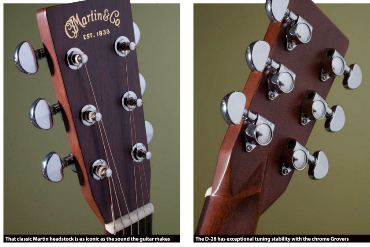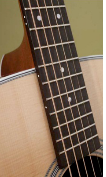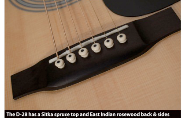Pick up a Martin D28 and you will realize that you are not just picking up a guitar, but a musical history, a symbol. In fact, only Gibson’s Les Paul model and Fender Stratocaster can be compared in history.
This award-winning D-type guitar also has many loyal fans in the music industry such as Elvis Presley, Johnny Cash, Joni Mitchell, Neil Young and even John Lennon. Therefore, its status does not need to be described. Of course, most of these musicians used the Martin D-28 version before 1969. As we all know, the later versions have undergone many changes in design. We are going to talk about the latest factory Martin D-28.

- Production skills
For us, it is easy to compare this guitar to its pre-1969 model. The herringbone pattern decoration was removed, and more importantly, the Indian rosewood replaced the Brazilian rosewood.
However, I think these are unfair to this guitar . Personally, the new Martin D28 should be examined objectively and at the same level. So, let’s talk about it from the production side.

The configuration of the body material should be familiar to us. Sitka spruce top, Indy rosewood back side panel (69 years ago was Brazilian rosewood). However, Martin has recognized the importance of sustainable wood development than other companies. Therefore, the configuration of Rosewood was also converted to Indy Rosewood before other companies. Spruce top uses high-grade materials, although some people are plagued by the chromatic aberrations and yellow-brown stripes of today’s spruce panels. However, after a period of use, these stripes will naturally mature into amber. Rose wood back sides panels, we can see the beautiful pattern, and the book centerline is based on the decorative center line. This is also a feature that Martin has always insisted on.
2. For the first time in history: composite materials
The body frame protector and the hammer patch use a composite material called Boltaron. This is also a new change to follow the traditional look. In fact, these parts should have properly protected the entire body and follow the traditional guitar appearance. The neck can basically be determined to be mahogany. Although Martin himself did not specify the material in the product manual, the texture and smell of the material can be determined to be mahogany. Close to the guitar head we can see the most classic diamond design, Martin has a proud work, the coil is using Grovers.
Looking closely at the fingerboard section, we can see Martin’s iconic thick ebony fingerboard. The fret wire is medium in size and perfectly embedded on the fingerboard without any rough burrs and blockage. This is also an aspect of my favorite.

The nut and bridge are made of bone material, which is a chamfered compensating (16-inch chord) bridge that is firmly embedded in the ebony bridge.

Look inside again. Although not directly observable, the internal structure uses Martin’s classic X-bracing, using the Sitka spruce support strip to achieve the classic Martin sound.
In general, the guitar’s manufacturing skills are undoubtedly worthy of the title of the world’s top instruments. It is also worth mentioning that there is no cumbersome and waste inside the body, only the iconic ship-type backplane middle beam. It’s time for us to pick up the guitar and play a few chords to listen!
3. Sound quality
I think you should be very clear, when you pick up a high-quality instrument, you will immediately feel it. That’s right, I picked up the first moment of the Martin D-28, and that’s how I feel. When I picked it up for the first time, I played hard for nearly an hour. You know, not all guitars will make me like this. The thin neck of the matt makes me feel that the hand and the neck can be almost integrated. Finger chords and intense sweeps are easy.
Speaking of the sound, I still want to say that Martin’s iconic voice has been imitated and never surpassed. Almost like a fingerprint, it is engraved on every Martin guitar. You will react as soon as you hear that voice. Ah, this is Martin’s voice, and this is the classic sound that is distinctive in many albums. It has sweet characteristics, but never loses strength. The deep guitar body created its full midrange response, and the sustain is not comparable to any other brand. After that we have to mention the low frequency, Martin’s low frequency response is usually become the “piano” sound. From the Martin D28, we are more likely to feel this trait. In fact, Martin’s biggest feature is not in a particular frequency band, but the clarity of each frequency band.
This time I specifically transferred the strings to DADGAD, and I am happy to tell you that the Martin D28 also has excellent performance under this tuning. People have been controversial whether the D-type guitar is suitable for fingering. In this respect, I give the Martin D-28 more than just a few scores, but fine. Of course, what I said is not counted. You can look at Michael Hedges and his D-28.
(not 69 years ago version). I believe that he is of course an expert in the fingerstyle playing.
4. Summary of the words
I always remind myself that this time I got a new guitar, and its voice will definitely be more mature later. Of course, I will not hesitate to take it now and do a show or something. For a serious musician, this is your choice. He is a hard-working old horse, serving your recordings and scenes with its classic sound and unique history. I don’t care who is arguing with me about this question, so I said that Martin is still making the top instruments like before.